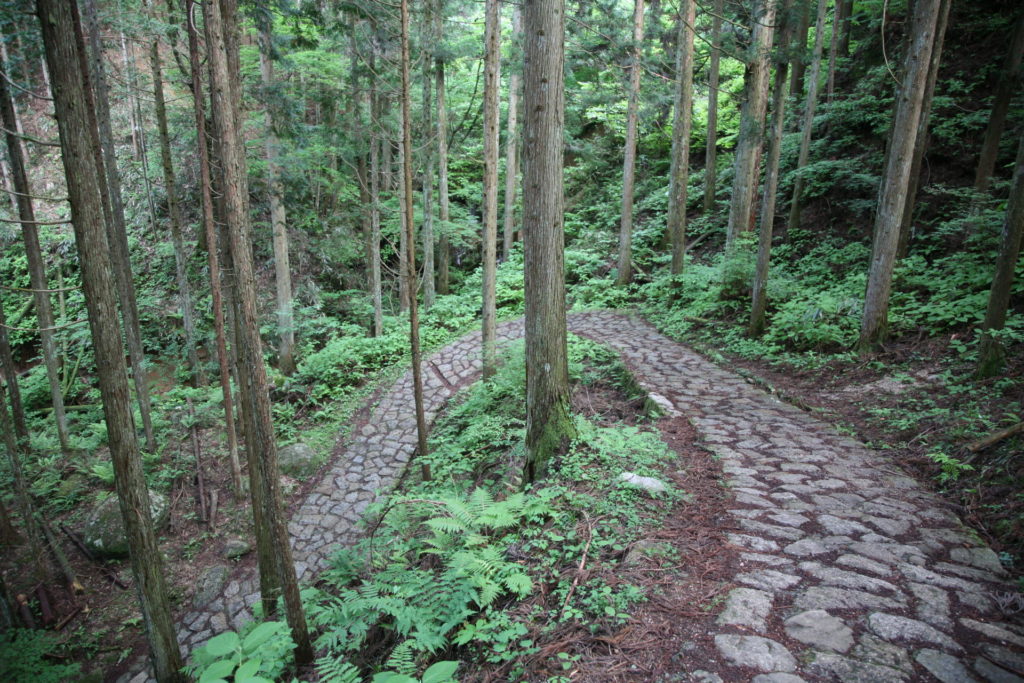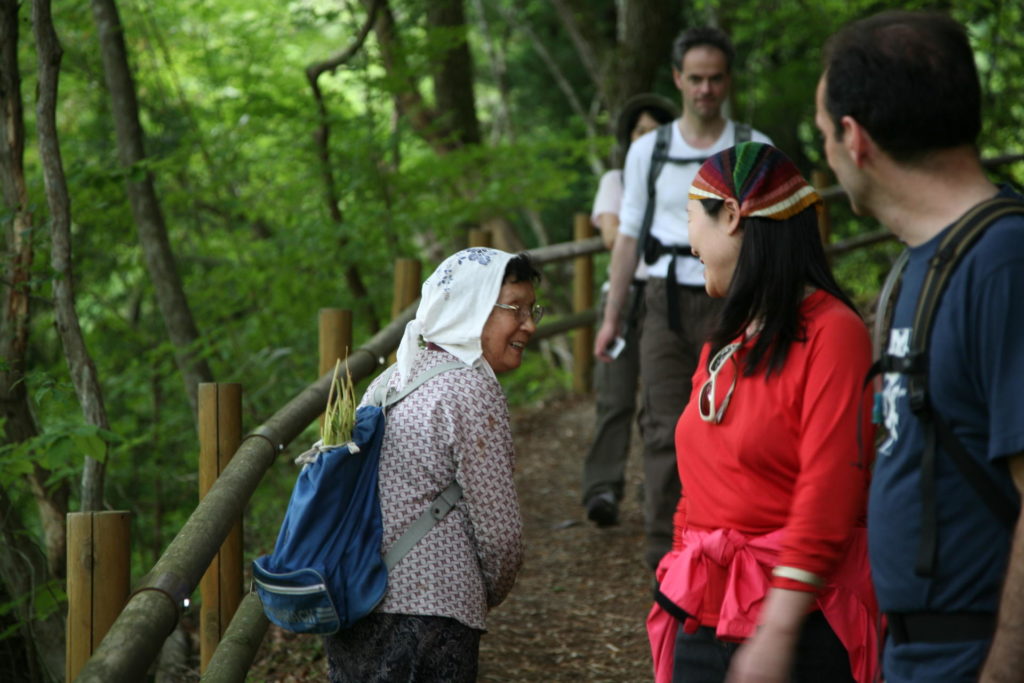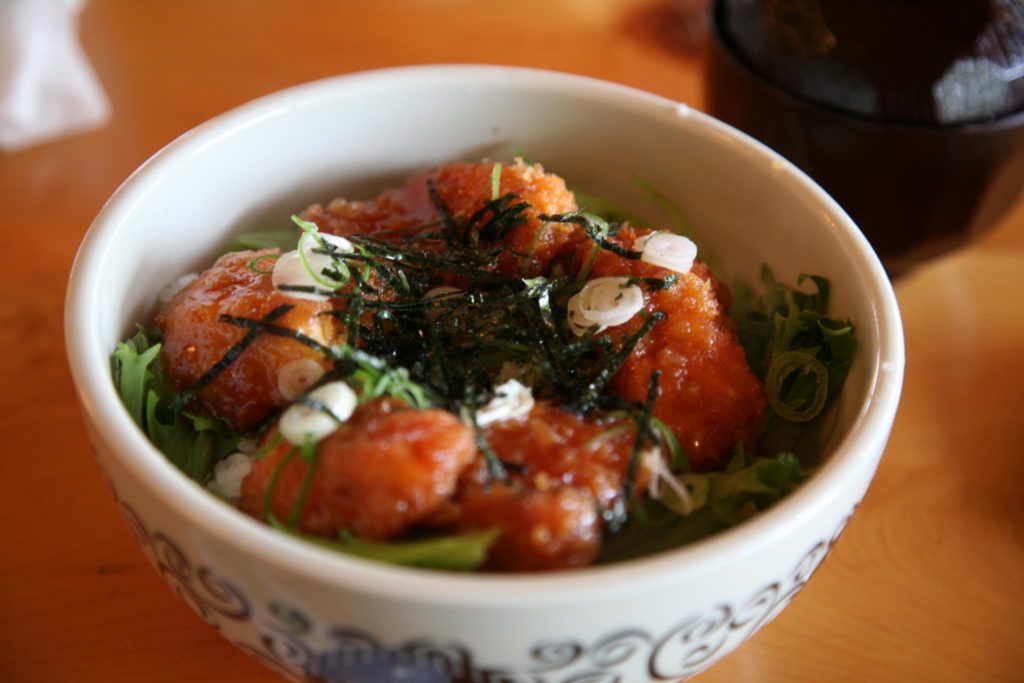
For months I have relished the prospect of spending four uninterrupted days hiking from village to village, exploring one of Japan’s ancient kaidō (trails). Finally, I find myself on the trail, maps in hand, ready to explore the Nakasendō (中山道), which translates to “Middle Road” or “Central Mountain Route.” During the Edo Period (1603-1868), it linked Kyoto to Edo (Tokyo), running through the modern-day prefectures of Saitama, Gunma, Nagano, Gifu and Shiga.
The Nakasendō was one of the gokaido (five official routes) maintained by the Tokugawa Shogun. Daimyo (feudal lords) made regular journeys to Edo as part of the sankin kotai system of “alternate attendance,” in which they were forced to spend alternate years in Edo, keeping their families effectively there as hostages and diminishing any possibility of revolt.
The Nakasendō was sometimes called the “Himekaidō” (Princess Road), since princesses sent to Edo for marriage with the Shogun took this route, as it was safer and less liable to flooding than the other route connecting Kyoto and Edo, the Tōkaidō (East Sea Road), which follows the coast.

Another name for the trail was the Kisokaidō (木曾街道), and one of the best preserved sections of the Nakasendo is found in the beautiful Kiso Valley which connects Nagano and Nagoya. The juku (post-towns), overnight rest stops for samurai, traders and feudal lords, have been thoughtfully preserved here, with many village houses now functioning as minshuku (inns).
In the 1960s, when traditional buildings were in disrepair and other villages were knocking them down in favor of modern pre-fabricated homes (often with the encouragement of local authorities), the Kiso villagers decided instead to restore them. The rules they set in place, such as owners not being allowed to sell or alter them, have preserved part of a vanishing rural landscape.
On the first day of my journey I find myself standing in Magome, one of the 69 juku (stations) on the original Nakasendo. At the entrance to the village is a sharp turn called a masugata (square shape), a defensive measure often used in Japanese castles.
The long central cobblestone street runs between machiya, traditional wooden houses often referred to as “bed of eels,” as they are long and narrow. Some operate as shops or cafés, selling the local specialty, gohei–mochi, sticky pounded rice covered in a thick sauce made of miso, sesame and walnuts.
My first hike takes me over Magome Pass to Tsumago, the most popular section of the trail. Leaving Magome, the path rises gently and is easy to follow. Half an hour out of the village, I stop by a small restaurant selling soba noodles and run by the wife of the village postman.
After reaching the pass, I descend on a dirt trail, reaching a small cha-ya (tea house), modeled after the cha-ya that would once have lined this and other kaido around Japan, offering rest to weary travelers.
Three hours into the hike I arrive in Tsumago and get my first opportunity to stay in one of the machiya. The scene here is one of the most evocative of the Nakasendo post-towns. The view cannot be much different than during feudal times. Overhead wires and modern buildings are banished. Tourists do turn up in the middle of the day, but few stay overnight, and I feel wonderfully privileged. I take a walk before dinner as the village is almost deserted.
The Daikichi Minshuku sits at the far end of the kilometer-long village. Three generations of the Hara family run the inn which features five simple yet clean rooms and fresh, beautifully-prepared food. The family grows many of the ingredients and forage in the surrounding hills for sansai (mountain vegetables).
The next morning, after a hearty breakfast, I look through my walking itinerary for the day. The weather looks good, so I opt for the longer of the two suggested routes to the next stop, Kiso-Fukushima. With map in hand, and using the accompanying route notes, I hike one hour to the town of Nagiso, then head uphill. I walk by fields full of soba and rice. Locals tending their plots smile encouragement as I walk by.
The six-hour hike takes me to another low pass on a well-marked trail, then through the woods and down a paved road to Nojiri. Here I catch a local train for the 15-minute ride to Kiso-Fukushima, the largest town in the central Kiso Valley and the political center of the Kiso Region. Travelers were required to stop here at the main sekisho (checkpoint) in order to control smuggling and make sure families of the feudal lords did not abscond from Edo.
My accommodation for the night is Koma-no-yu, a comfortable (hot spring) ryokan. After muscles are soothed in the bath and a stomach full with a six-course meal, I fall into a deep sleep in anticipation of my next hike.
The following day I start the next section, over the Torii Pass from Yabuhara to Narai-juku. Yabuhara was known for its oroku-gushi (combs) made from local birch trees, manufactured here until the 1960s when plastic combs appeared.
After a brief but brisk climb, I reach the pass. To the left I can see Mt. Ontake, the second-highest volcano in Japan at 3,067 meters. I ring the bell by the trail to ward off bears, and start descending to Narai. Once known as the village of a thousand inns, it was the most prosperous of the Nakasendo post-towns.

The contrast with Yabuhara, whose residents decided not to restore their traditional houses and impose strict rules on their ownership, is stark. While Yabuhara is encumbered with modern pre-fab houses and the usual cobweb of cables, Narai, like Magome and Tsumago, has been able to elegantly preserve the past. Yet it manages not to fall into the trap of becoming a living museum or Disney-esque theme park. It is a working village, and its residents have lived here for generations.
My last night is spent at Iseya, where Masaki Sakaiya and his parents manage the inn with evident pride. The walls inside their 200-year-old machiya house have a deep burnished shine up to head height, a result of generations of young women in the family polishing the wooden walls coated with soot from the irori (sunken hearth).
My last hike, more of a gentle stroll, takes me from Narai to Hirasawa, a center of the lacquer ware trade. Dozens of shops sell bowls, hondana (bookshelves), tables and other wooden objects coated in layers of lacquer. You’ll be tempted to pick up some beautiful mementos, but if your budget won’t stretch very far, you can at least take home a pair of nice chopsticks.

Self-Guided Walking Tours
I am not one for group tours. I’m too independent, and perhaps stubborn, to travel with a guide and a bunch of other people. I like to do things at my own pace, to be able to stop and browse in shops and take as many photos as I want without feeling guilty about holding up the group.
Yet I find myself tramping through the Japanese countryside on a “guided tour” discovering one of the old kaidō. The great thing about self-guided tours is that, other than bringing the right gear and knowing how to get to the start of the trail, you don’t need to do any preparation.
The self-guided walking pack includes a hiking map, step-by-step trail guide, train tickets and pre-paid reservations at historic inns along the way. There is also a phone number to call in case of a problem, but other than that you are on your own, just you the trail and the adventure.
The Nakasendō self-guided walking tour can be done as a 3, 4, 5 or 10-day trip. The best time to hike is from April to November. For more information contact Oxalis Holidays, http://oxal.is




